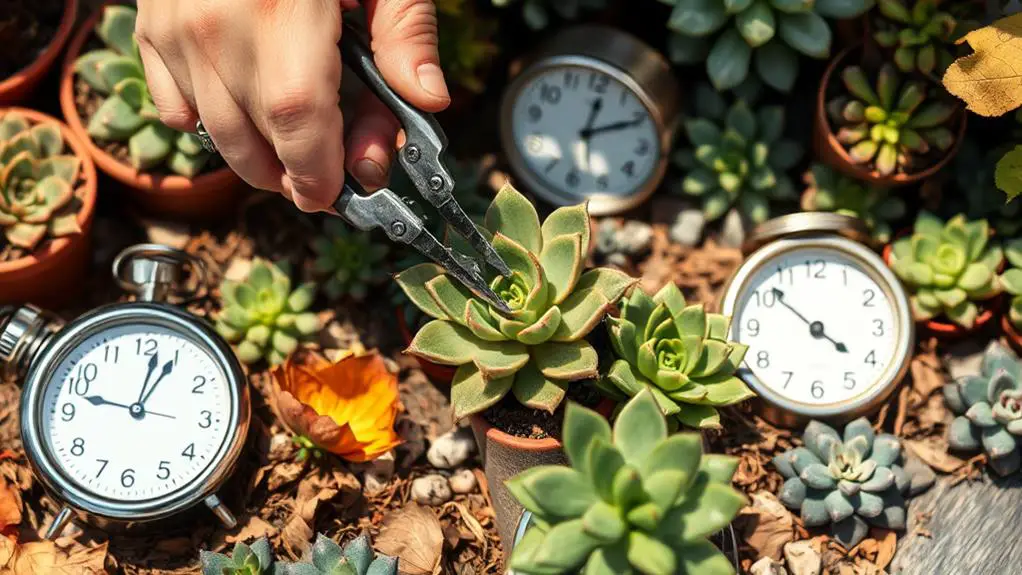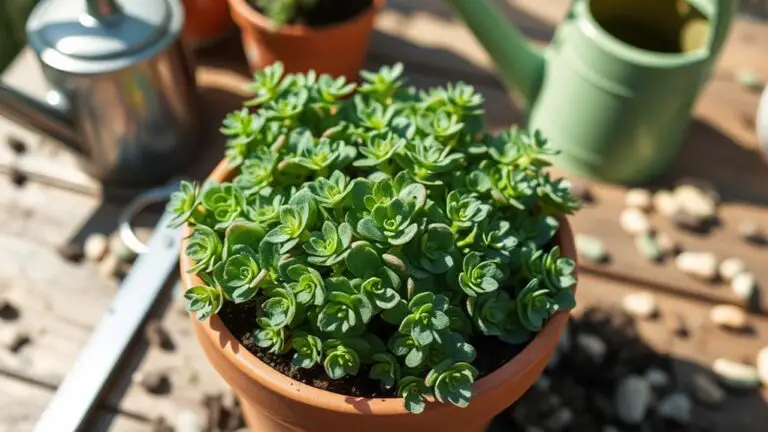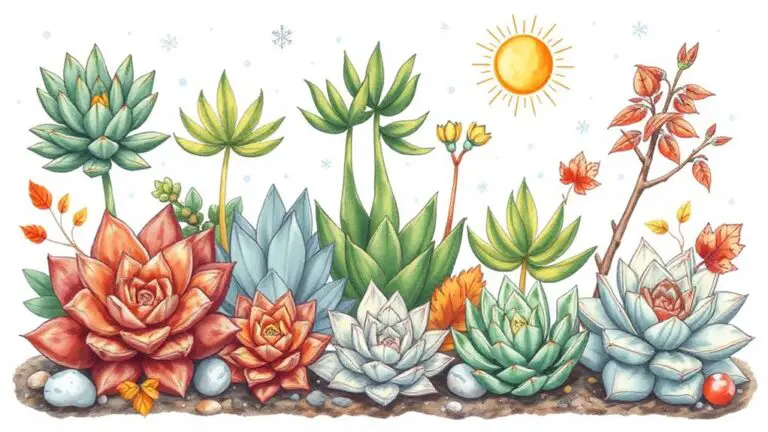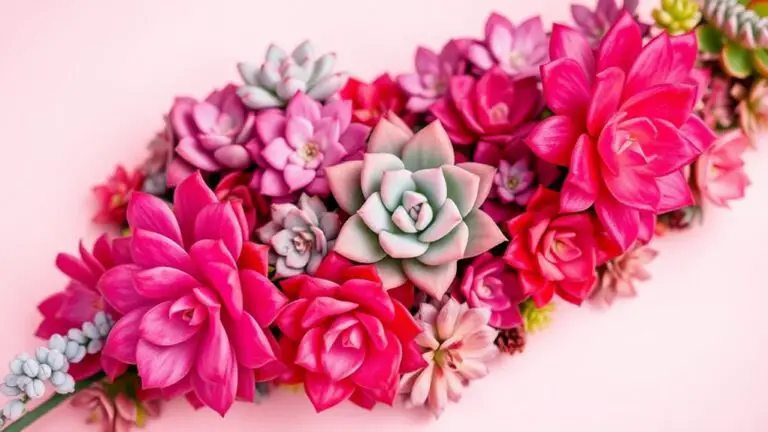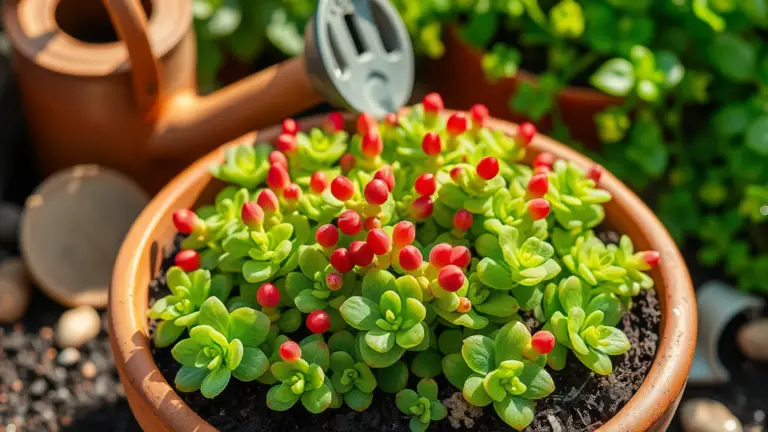Prune Your Succulents in 7 Essential Steps With Timing Tips
Pruning your succulents might seem intimidating, but it's easier than you think when you follow seven essential steps. Start by choosing the right time—spring and summer offer the best conditions. You'll need some basic tools and a keen eye to examine your plants. Making clean cuts at the proper angles guarantees healthy regrowth. Ever wondered why you need to let the stems dry before replanting? And what about the best post-pruning care to make certain your succulents thrive? Let's break down each step so you can master the art of succulent pruning.
Select the Right Time
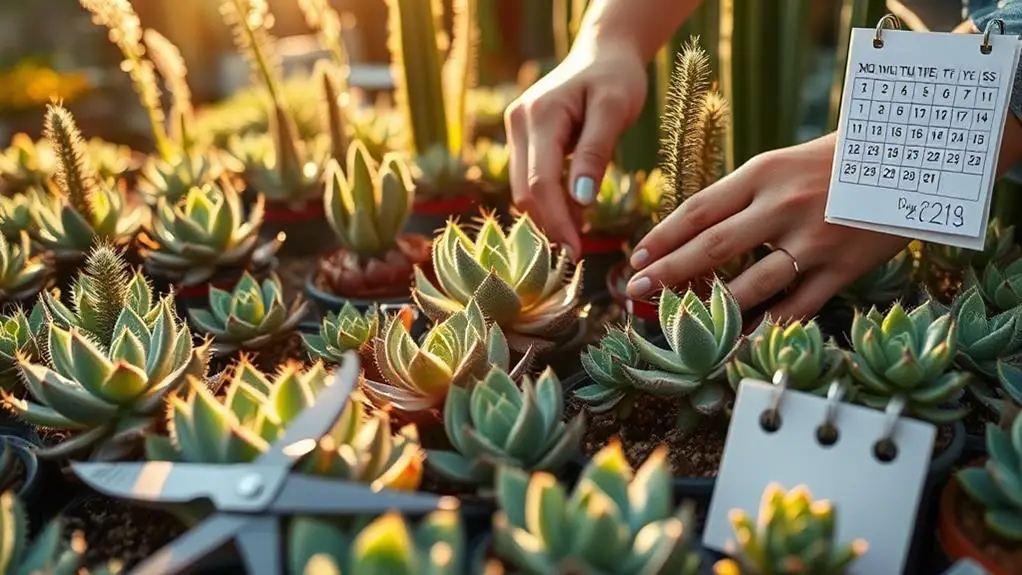
Selecting the right time to prune your succulents is essential for their health and growth.
You'll want to use your pruning shears during the spring and summer months when your plants are actively growing. This is the best time because your succulents will recover quickly and promote new growth.
Avoid pruning in the winter since succulents are dormant and more prone to stress. Early spring is perfect, as it marks the start of the growing season, giving your plants ample time to heal and thrive.
Don't forget to monitor your local climate, as regional temperatures can affect the timing. Regular pruning during these months keeps your succulents healthy and helps manage their growth patterns effectively.
Gather Necessary Tools
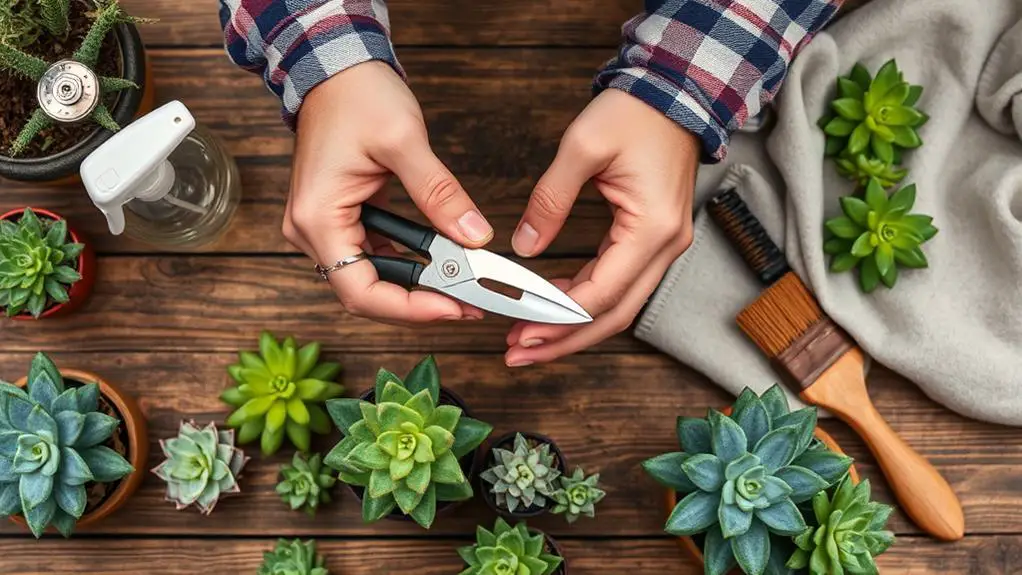
Before you start pruning your succulents, gather all the necessary tools to make the job easier and safer.
You'll need sharp pruning shears or scissors for clean cuts, gloves to protect your hands, and a clean cloth or disinfectant to sanitize your tools.
Don't forget a container for debris and a cactus catch-all tray to keep everything tidy.
Essential Pruning Tools
When it comes to pruning succulents, having the right tools on hand is essential for maintaining plant health and ensuring clean cuts.
First, you'll need sharp pruning shears or scissors to make those clean cuts that minimize infection risks. For larger succulents, long-handled shears help you reach higher or hard-to-access spots. Floral snips are perfect for precision work on smaller or delicate succulents.
Always remember to sanitize your tools with alcohol or disinfectant before use to prevent spreading diseases between plants.
And don't forget to wear gloves, especially when handling spiny succulents or those with irritant sap.
With these tools, you're well on your way to successful succulent pruning!
Tool Preparation Tips
Regularly preparing your tools before pruning succulents guarantees a smoother and more effective process. Start by ensuring your pruning shears or scissors are sharp. Sharp tools make clean cuts, reducing the risk of infection and stress to the plant. Always sanitize your tools with disinfectant or alcohol to prevent spreading diseases between plants. Consider using gloves to protect your hands from spines and irritants, especially when dealing with cacti or Euphorbia. Have a container ready to collect debris, keeping your workspace tidy. Long-handled tweezers are useful for making precise adjustments in hard-to-reach areas.
| Tool | Purpose |
|---|---|
| Pruning Shears | For making sharp, clean cuts |
| Disinfectant | To sanitize tools and prevent disease |
| Gloves | Protect hands from spines and irritants |
| Debris Container | Keeps workspace organized |
Examine Your Succulents
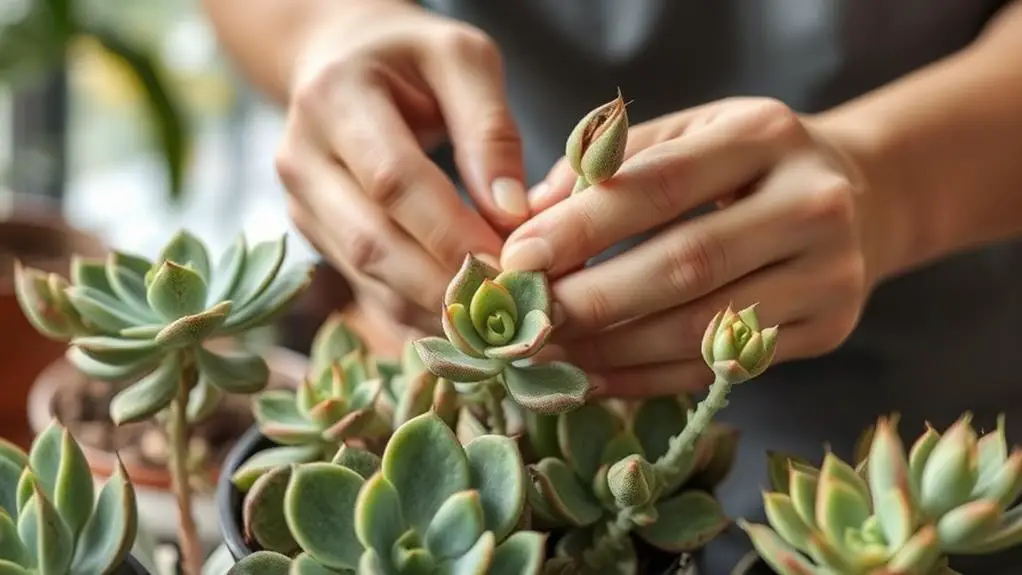
To guarantee your succulents thrive, start by inspecting them for any dead, damaged, or diseased leaves that need removal.
Carefully inspect your succulents, paying attention to any dead leaves or damaged leaves. These can hinder growth and invite pests. Look closely at the stems and leaves. Yellowing or mushy leaves often signal overwatering or root rot.
If you notice leggy stems or overcrowded growth, it's time for some shaping. Assess the plant's growth pattern to understand its natural habits. This will help you make informed pruning decisions.
Evaluate the overall structure to see if trimming is needed to maintain a desirable shape and size. Regular checks guarantee your succulents stay healthy and attractive.
Make Clean Cuts
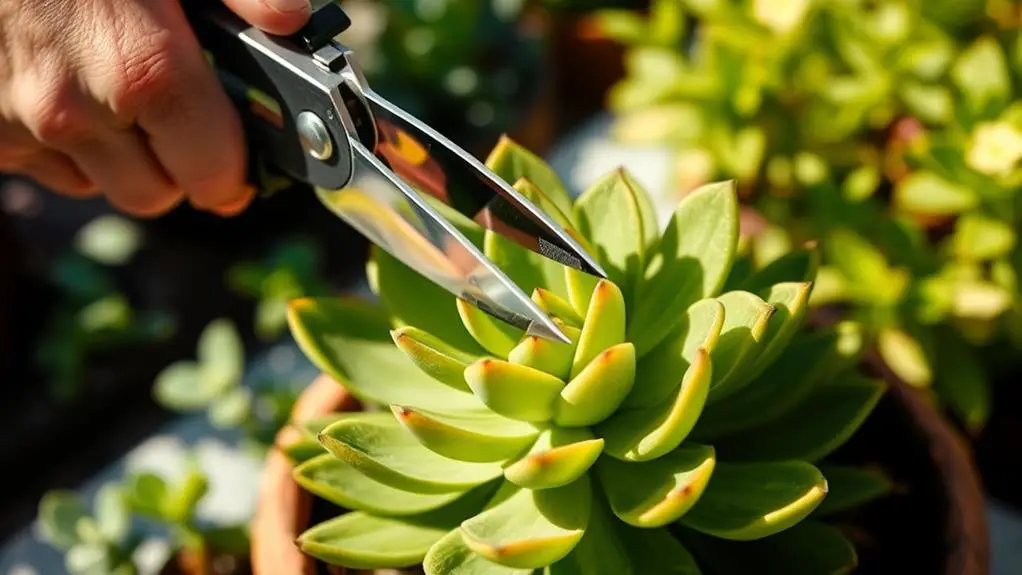
To make clean cuts, you'll need sharp pruning shears or scissors that minimize damage to your succulents.
Sanitize your tools before cutting to avoid spreading diseases, and always cut at a 45-degree angle near the leaf node.
This way, you won't damage the stems and your plants can regrow healthily.
Use Sharp Tools
When pruning succulents, it's crucial to use sharp, clean tools to guarantee the health and beauty of your plants.
Start by using a sharp knife or specialized pruning shears to make clean cuts. These pruning techniques help minimize damage to the succulent tissues. Always sterilize cutting tools with alcohol or disinfectant before use to prevent spreading diseases.
Aim for clean cuts at a 45-degree angle near leaf nodes. This promotes healthy new growth and enhances your plant's appearance.
Replace dull or rusty tools promptly to avoid crushing stems, which can stress the plant and lead to disease. Verify your tools are designed for the specific pruning task, like bonsai scissors for delicate trimming.
Sanitize Before Cutting
Start by sanitizing your tools to protect your succulents from harmful pathogens.
It's essential to use clean, sharp pruning shears or scissors for the best results. Before you begin, wipe the cutting edges with alcohol or a bleach solution to eliminate any pathogens that could harm your plants' health. This step guarantees that your succulents stay vibrant and free from disease.
After each cut, use a clean cloth or paper towel to wipe down your tools, preventing cross-contamination between different plants. Avoid rusty or dull tools since they can create jagged cuts, increasing the risk of infection.
Regularly maintain your tools' cleanliness, especially when working with multiple plants, to keep your succulent collection thriving.
Avoid Damaging Stems
After ensuring your tools are sanitized, it's important to focus on making clean cuts to avoid damaging the succulent stems.
When you prune your succulents, use sharp, clean pruning shears to make precise cuts. This helps minimize damage and reduces the risk of infection. Always cut at a 45-degree angle near a leaf node to encourage healthy new growth and prevent water from pooling on the cut surface.
Limit stem removal to no more than one-third of the total length to avoid shocking the plant. Crushing or tearing the stem can lead to stress and possible rot, so handle with care.
Trim Faded Blooms
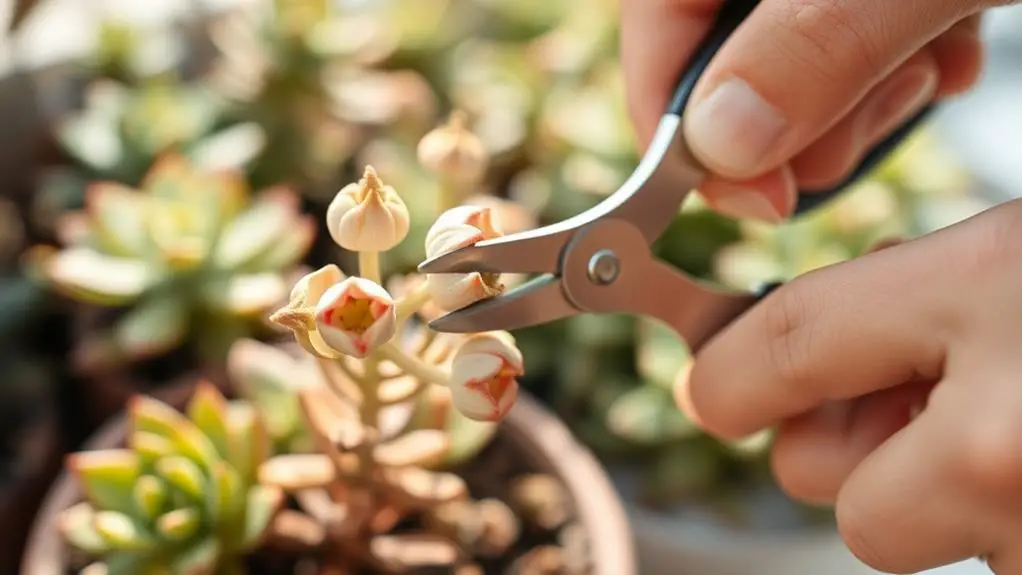
Pruning faded blooms from your succulents is essential for their overall health and vigor. When you trim faded blooms, you prevent the plant from wasting energy on seed production, allowing it to focus on new growth. Use sharp, sterilized scissors or shears to make clean cuts at the base of the flower stalk. This helps keep them healthy by minimizing infection risks. Cut just above the leaf node or stalk base to encourage new growth and maintain the plant's shape. After trimming, monitor your succulent for signs of new growth and any distress, like wilting or discoloration.
| Task | Tool |
|---|---|
| Trim faded blooms | Sharp, sterilized scissors |
| Cut at base of flower stalk | Scissors/Shears |
| Minimize infection risks | Sterilized tools |
| Encourage new growth | Prune above leaf node |
| Monitor plant's response | Visual checks |
Regularly check for any signs of trouble and adjust care as needed.
Allow Stems to Dry
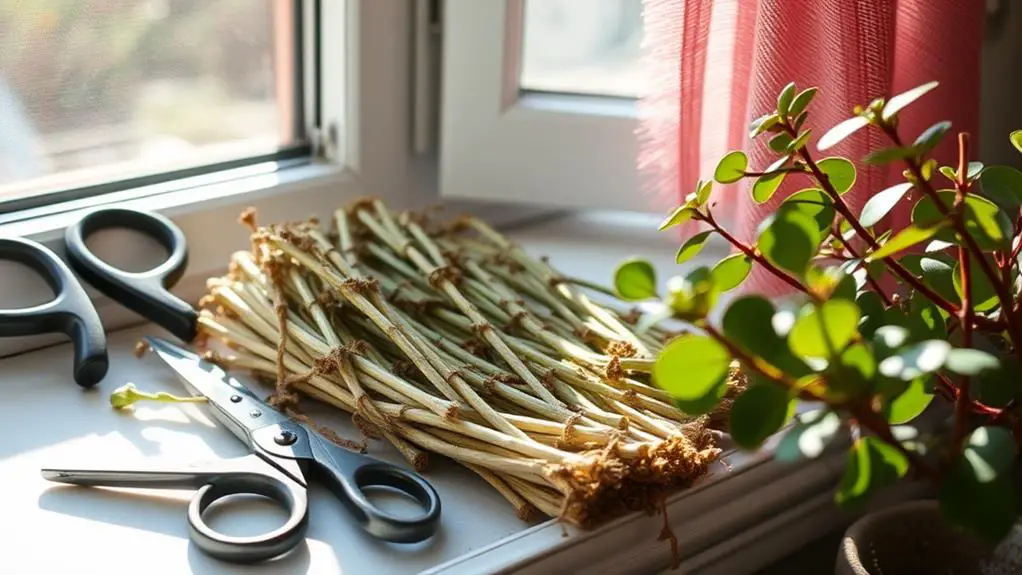
When you've finished trimming your succulents, it's crucial to let the cut stems dry for 3-5 days. This drying process helps the cut surface form a protective layer, reducing the risk of rot and infection.
Place the cut stems in a well-ventilated area, away from direct sunlight, to allow them to dry evenly. This step is especially important for succulents with thicker, fleshy stems, as they hold more moisture.
- Minimize rot and infection: Prevents moisture-related problems.
- Form protective layer: Helps in healing and reduces moisture loss.
- Ensure proper drying: Well-ventilated area is key.
After the stems have dried, you can replant them in well-draining soil to promote healthy root development. This careful preparation sets your succulents up for success!
Post-Pruning Care
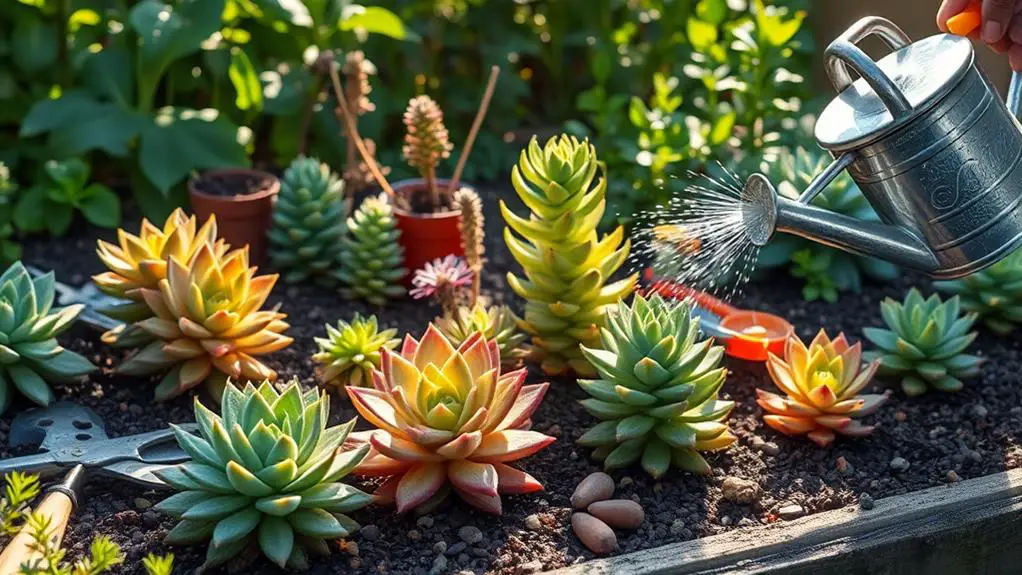
Once the stems have properly dried and formed a protective layer, it's time to focus on post-pruning care to guarantee your succulents thrive.
Start by planting the cuttings in well-draining soil. Water sparingly, letting the soil dry completely between waterings to avoid over-saturation.
Place your pruned succulents in a bright area with indirect sunlight, which helps them recover without the stress of direct exposure. Keep an eye on them for any signs of distress like wilting or discoloration, and adjust your care as needed.
A few weeks after pruning, lightly fertilize with a diluted fertilizer suitable for succulents to encourage new growth.
With these steps, your succulents will be on their way to healthy, robust growth.
Frequently Asked Questions
When to Cut Succulents Back?
Prune your succulents in early spring for ideal regrowth, or summer when longer daylight aids healing. Avoid winter due to dormancy. For flowering types, cut back right after blooming. Always consider your local climate variations.
How Do You Prune Potted Succulents?
Start by trimming dead or damaged leaves with clean, sharp shears. Cut no more than one-third of the stem. Prune during active growth seasons, let ends callous before watering, and monitor for stress. Lightly fertilize if needed.
What Happens if You Cut the Top off a Succulent?
If you cut the top off a succulent, you'll stimulate new growth from the remaining stems, leading to a bushier plant. However, make sure the plant isn't young or stressed to avoid shock and potential harm.
Should I Cut the Flower Stalks off My Succulents?
Yes, you should cut the flower stalks off your succulents. Doing so helps the plant conserve energy, encourages new growth, and maintains its health. Use sharp scissors and cut right after the flowers fade for best results.
Conclusion
You've got all the steps to prune your succulents right here! Just remember to choose the right time, gather your tools, and carefully examine your plants. Make clean cuts and trim any faded blooms. Let the stems dry before replanting, and give them the care they need post-pruning. With these tips, you'll keep your succulents healthy and thriving. Don't worry, you've got this—your plants will thank you for it!

